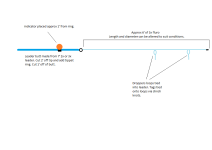Drop shot is nothing more than rigging your flies on short dropper tags and having the weight on the "point" or very end of the leader, several inches below then bottom dropper.
There is no requirement to fish it on a tight line, under an indicator, or with a specific amount of weight. I've been seeing a lot of confusion online and I believe that it is due to folks who don't really see the bigger picture and try to associate this fly/weight configuration with a specific style of nymphing whether it be tight line or "bounce"/"pogo".
When fishing this configuration in a tight line method, you are essentially doing the same as you would if you ran a heavy "anchor" fly on the point. Since you aren't fishing a tournament, you have the luxury of replacing the weighted fly with split shot and are thus able to fine tune your weight without the need for a bazillion differently weighted flies. You also aren't snagging and losing flies, the shot snags less and often slips off the end of the line if it does.
You can fish it under and indicator like you would any other nymph rig. Place you indicator about 1 1/2 to 2 times the water depth in relation to the weight and have at 'er, adjusting indicator placement and weight as needed. This IS NOT necessarily the bounce rig that has gained popularity on very specific waterways. A bounce rig requires an extreme amount of weight, and a very large buoyant indicator as much as it requires a drop shot rigging. You can also do sort of a hybrid configuration adding a dropper above the weight on a conventional straight-through indicator rid. Personally, I find tight line and floating indicator methods to be complimentary. There are places where one is just a better, more practical choice than the other and vice versa. To many guys are falling into the trap of dogma in regard to methods. Be versatile and be a better angler.
Now with all that said, regardless of whether I am tight lining or fishing a bobber, I rig using a drop shot configuration over 3/4 of the time. I think that it is inherently better for detecting strikes and that goes for both tight line and indicator methods. Is it also inherently better at drawing strikes in the first place? Well, I dunno, but it works so well, so often that it is my go-to.




